Live Oak Tree: Leaves, Bark, Fruit (Acorn): Pictures, Identification and Growing Guide

The live oak tree is an impressive evergreen tree with sprawling branches, leathery lanceolate leaves, and dark brown or black egg-shaped acorns. Live oak trees grow rapidly, and they are beautiful specimens or shade trees for any landscape. Once established, live oaks are easy to care for and adapt well to most soil types. Under ideal conditions, live oak trees can grow for hundreds of years.
Also called the southern live oak, the medium to large-sized oak tree thrives in Florida, Texas, and other states in the south. Its broad, spreading canopy, thick trunk, and gnarled branches make the live oak a tree of beauty in warm climates.
This article is a complete guide to the live oak tree. Descriptions and pictures of the oak tree leaves, bark, flowers, and acorns will help identify this picturesque tree. In addition, you will find helpful tips on growing a live oak tree in your landscape.
Live Oak Tree Facts
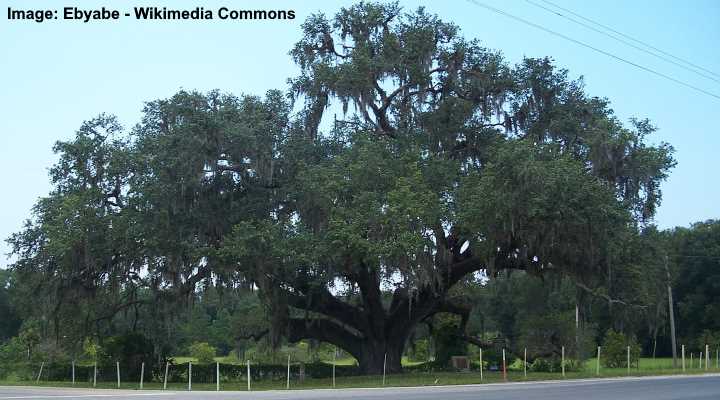
Live oak tree (Quercus virginiana)
The live oak tree (Quercus virginiana) is described as a medium to large-sized evergreen that grows between 40 and 80 ft. (12 – 24 m) tall and up to 100 ft. (30 m) wide. The majestic oak tree is characterized by its sprawling, twisting branches, black acorns, leathery dark green leaves, and reddish-brown furrowed bark.
The live oak is native to southern states from Virginia to Florida and west to Texas. The stunning hardwood tree thrives along coastal plains and woodlands where it gets full sun and grows in most types of well-drained soil that constantly stays moist. The tree is also tolerant of salt, occasional drought, and flooding.
Live oak trees perform best in USDA zones 8 through 11.
A characteristic identifiable trait of the southern live oak tree is that its gnarled branches are often covered in Spanish moss. This moss covering gives the curling branches a soft appearance. On some of the older trees, the moss is seen hanging from branches giving the tree a somewhat weeping appearance.
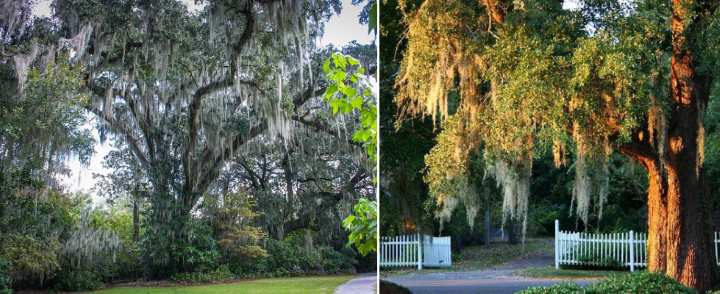
Live oak trees covered in Spanish moss
Live oak trees grow at a rate of 24” to 36” (60 – 90 cm) per year. Growth is faster when the tree is immature, and a live oak tree sapling will quickly take shape, becoming a stunning hardwood tree with a rounded crown. This means that correct pruning in the first few years after planting is vital for the tree to grow strong and develop a beautiful shape.
What Is Texas Live Oak Tree (Quercus fusiformis)?

Texas live oak tree (Quercus fusiformis)
Texas live oak tree is an evergreen tree native to the southern United States. The stately Texas oak tree is identified by its large, pointed acorns, bright green leathery leaves, and grayish scaly bark. Smaller than the southern live oak tree, Quercus fusiformis grows up to 40 ft. (12 m) tall and has a broader spread.
There are a few ways to distinguish between a Texas live oak tree and a southern live oak. First, the Texas live oak is identified by its smaller height and a less-spreading crown. Also, Texas live oaks have acorns with a pointed apex rather than a rounded tip.
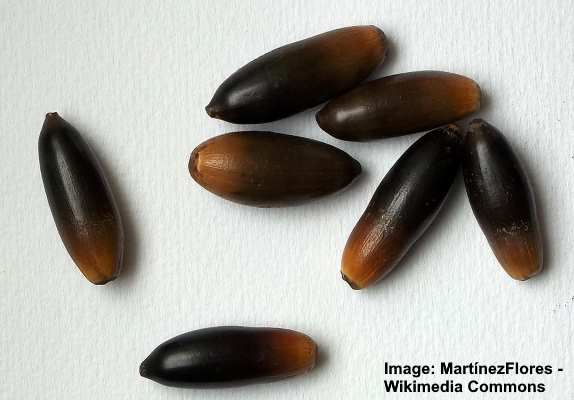
Texas live oak acorns have pointed tips
Live Oak Tree In Florida
Southern live oak trees are ideal for growing in Florida’s warm and humid climate. The sprawling branches and dense spreading crown make it suitable as a magnificent shade tree. The live oaks are some of the most common oak trees growing in the Sunshine State.
However, there are also practical benefits of growing a live oak tree in a Florida landscape. According to some estimates, a mature tree can add tens of thousands of dollars to a property’s value. Also, the oak tree’s strength and resistance to wind damage make it a natural windbreak during hurricanes.
Live Oak Tree Leaves
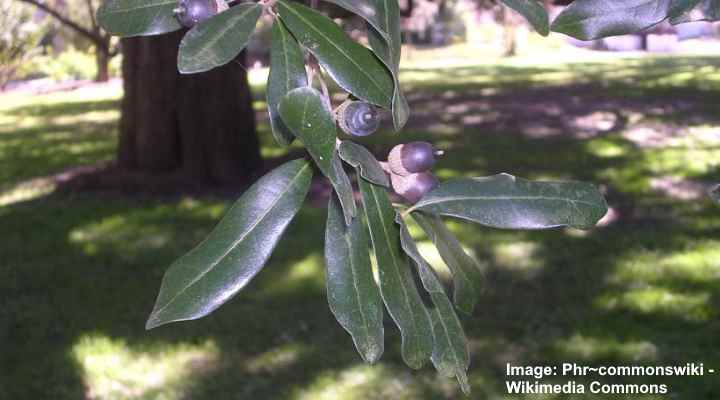
Southern live oak tree (Quercus virginiana) leaves and acorns
Leaves growing on a live oak tree are oblong, elliptical, glossy green leaves with a leathery texture. The oak leaves have a shiny upper surface and fine, grayish hairs on the underside. The thick green leaves grow alternately and measure 2” to 5” (5 – 13 cm) long and up to 1.5” (4 cm) wide.
The live oak tree leaves are one way to tell the tree apart from deciduous oak tree varieties. Typical oak tree leaves have characteristic deep, rounded lobes around the margins. However, live oak tree leaves have smooth edges without any lobbing.
Although live oak trees have evergreen foliage, they drop their leaves in spring. The leaf drop happens after new leaves have emerged on the tree, meaning that the oaks stay green throughout the year.
Live Oak Tree Bark
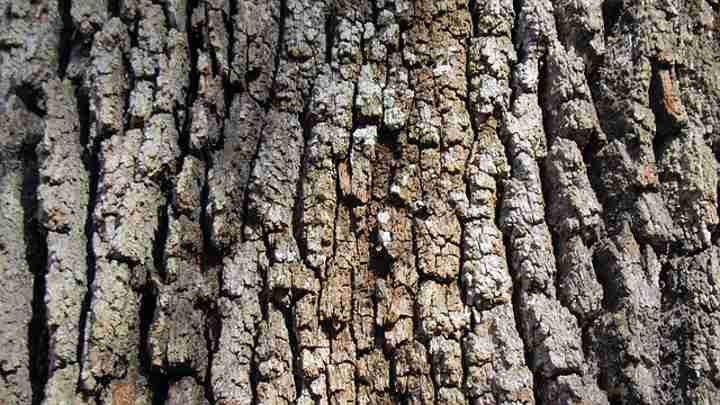
Bark of a mature Southern live oak tree
Bark on a live oak tree trunk is identified by its reddish-brown color with narrow furrows running vertically. As live oak trees mature, the bark becomes dark gray and develops a thick, scaly pattern with deep grooves. Finally, branches on live oak trees are pale gray covered in short hairs.
Live Oak Tree Flowers
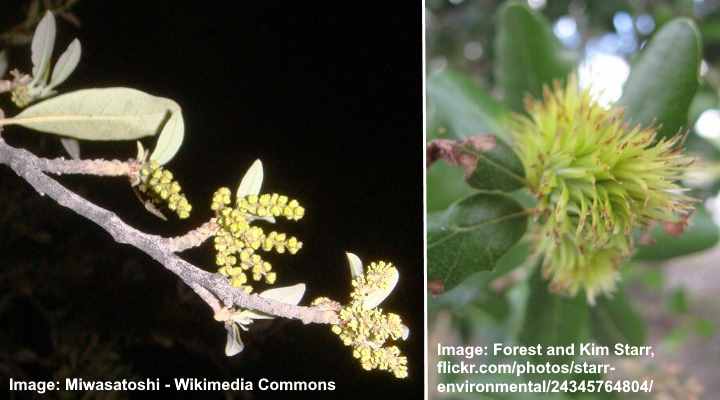
Southern live oak tree male flowers (left) and female flowers (right)
The live oak tree blooms in spring and produces clusters of drooping yellow-green male flowers. The dangling yellowish catkins are inconspicuous and don’t add any ornamental value to the tree. The slender cylindrical, pendulous clusters measure 2” to 3” (5 – 7.5 cm) long and grow in groups of one to five catkins. The female flowers are green to reddish short spikes.
Live Oak Tree Acorns
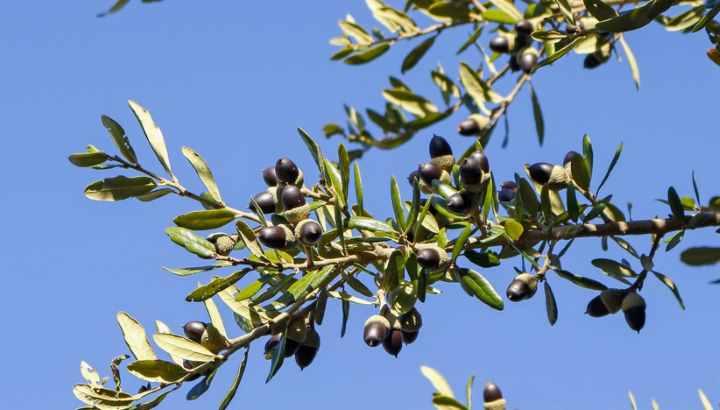
Southern live oak tree acorns
Acorns growing on live oak trees are dark brown to black egg-shaped nuts measuring 1” (2.5 cm) long. Like all oak tree acorns, the tree nuts have bowl-shaped caps covered in tiny, pointed scales. The scaly cups cover about one-third of the nut. Live oak tree acorns grow in clusters of one to five nuts.
The acorns mature in one season and are ready for harvesting from September until November.
How to Identify Live Oak Tree (Quercus virginiana)
The easiest way to identify a live oak is by its growth habit. Live oak has distinctive spreading, gnarled branches that grow horizontally, creating a rounded crown. Live oak tree identification is also by its leathery, lance-shaped, pointed leaves, dark-brown furrowed bark, and characteristic black acorns with a scaly cap.
Related reading: How to identify a white oak tree.
Where to Plant Live Oak Tree
Plant a live oak tree in the sunniest spot in your garden in well-drained soil. An oak tree thrives in full sun and should be planted where it gets at least six hours of sunlight daily. The planting location should be deep enough to allow the strong roots to grow well.
Ideally, the live oak sapling should be planted at least 15 ft. (4.5 m) from any structure. However, it’s good to note that a fully grown live oak tree can have a rounded canopy up to 120 ft. (36 m) wide. So, if the tree grows near a building, you will need to trim the branches.
Live oak trees tolerate most soil types, including loam, sand, clay, acidic, and alkaline. Ideally, the soil should be well-draining but retain enough moisture to keep healthy roots hydrated. However, live oaks tolerate wet soil occasionally. The hardy trees are also tolerant of drought and salty climates, making them ideal for planting in coastal locations.
Oak trees may take many years to reach their mature size. And the robust tree with its strong, dense canopy can provide year-long beauty. Planting a live oak in a large garden also protects from the hot sun and strong windy conditions, and even hurricanes.
Related reading: How to plant and grow a red oak tree.
How to Plant a Live Oak Tree
To plant a nursery-bought live oak tree, dig a hole twice the root ball’s size but the same depth. Next, plant the rooted tree in the hole, ensuring to untangle the roots if necessary. Then backfill the hole with topsoil, pressing it down as you go to remove air pockets.
Finally, thoroughly water the tree and spread a layer of mulch around the base of the tree. Water the young live oak tree once or twice a month during the first few years after planting. It’s best to apply water slowly over a long time to irrigate the roots thoroughly without waterlogging them.
You can usually hold off watering a southern live oak tree during the winter months unless the winter is particularly dry.
How to Grow Live Oak Sapling
Growing a live oak seedling starts from harvesting the acorns from the ground in October or November. You can plant the acorns directly in a large, deep container containing six parts potting soil and one part sand. Then thoroughly moisten the soil before planting the acorn.
Before planting, the first thing to do is put the acorns in a bucket of water and discard any that float. Then remove any cups from the egg-shaped nut.
To get a live oak acorn to germinate, fill a one-gallon (4.5 l) container with the potting soil. Then create a hole in the center of the pot and plant the acorns 2” (5 cm) deep. Cover with wire mesh and place outdoors in partial shade. Keep the soil moist by watering every so often. The oak saplings should appear in two to three months
In the following spring, you can transfer live oak saplings to the ground if they are at least 6” (15 cm) tall with a few unfurled leaves. After planting in the ground in a sunny spot, water the soil daily for the first two weeks. After that, water the young live oak tree weekly for the first three years if there has been little rainfall. There is no need to water a live oak tree during winter.
Live Oak Tree (Quercus virginiana) Care Guide
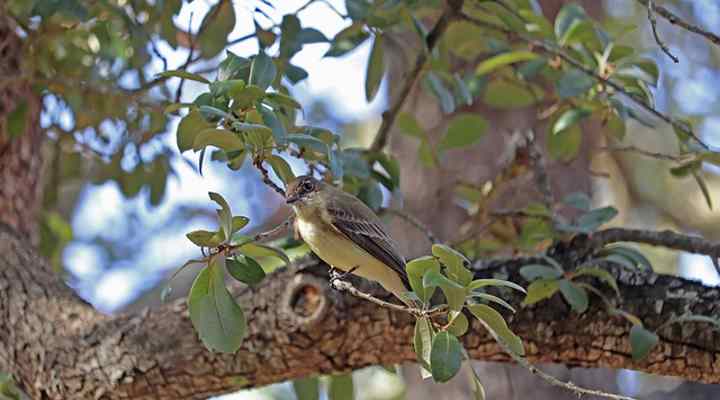
Live oak tree requires little care and is a low maintenance tree
Live oak trees thrive in direct sunlight and any type of soil that drains well. Therefore, aside from occasional watering during exceptionally dry periods, mature live oaks require little maintenance. Live oaks perform best in moist soil, but they are also highly resistant to drought. Additionally, live oak trees usually need no fertilizer at all.
How to Water Live Oak Tree
Mature live oak trees can survive well without additional watering. Established live oak trees are relatively resistant to drought, so you generally don’t have to worry about watering a sizable live oak tree. You only have to water a live oak during dry weather.
Watering a young live oak tree regularly is necessary to help the roots establish themselves. Usually, weekly watering is required during warm seasons for the first two or three years. However, it’s vital never to overwater your oak tree. Too much soil moisture can cause root stress, resulting in yellowing leaves and root rot.
Live Oak Tree Fertilization
Generally, there is no need to fertilize a live oak tree unless there are soil nutrient deficiencies. Instead, you can apply a thick layer of organic mulch around the root area every spring, leaving a few feet clear around the trunk. Also, adding some rotted manure or compost can help provide sufficient nutrients for your tree to grow.
Usually, if the live oak grows near a well-fertilized lawn, there is no need to provide additional nutrients. Or you can let the leaves that fall in spring remain on the ground and supply the soil with nutrients as they decompose.
How to Prune Live Oak Tree
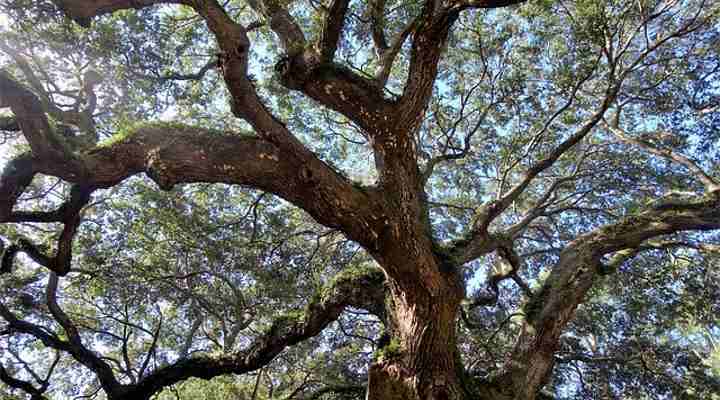
Live oak pruning is especially important in the first few years for it to grow strong and develops a beautiful shape
Pruning is the most crucial aspect of caring for a live oak tree. Regular pruning during the fall or winter in the first seasons will help establish a strong trunk and robust branch structure. The general rule with pruning a southern live oak is once a year for the first three years. After that, prune every five years until 30 years have passed.
The goal of pruning an immature live oak tree is to remove lateral branches growing two-thirds up the tree. This will let the tree grow with 15 ft. (4.5 m) clearance below the canopy to allow cars or people to pass under the tree.
Pruning a live oak tree involves identifying the main branch on the tree. You should then remove branches of a similar size so they don’t compete with the main branch.
Pests Affecting Live Oak Tree Growth
Southern live oak trees are popular landscaping trees because they grow quickly and produce beautiful foliage. However, foliage on live oaks is vulnerable to certain types of insect pests that can cause damage.
Several types of insect pests can infest oak trees, including aphids, lace bugs, acorn weevils, caterpillars, and oak sawflies. Recognizing the types of insects causing damage to live oaks is essential for controlling them.
Acorn weevils burrow into acorns and feed on the flesh of the nuts. The small brown beetles are the principal reason acorns fail to germinate. However, the acorn weevils won’t harm the tree’s health.
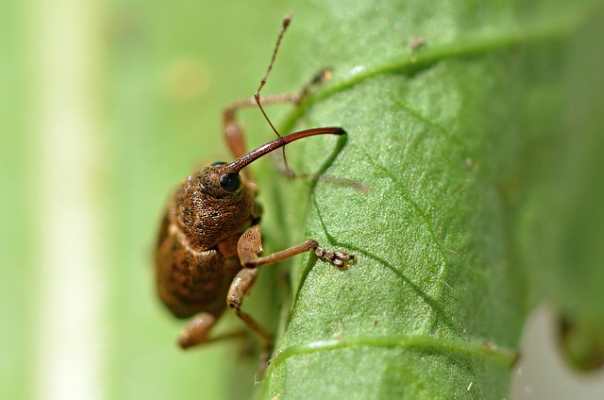
Acorn weevil
Live oak galls occur when insects and mites lay eggs on the oak trees. When the larvae start feeding on plant tissue, the live oak tree reacts by producing various types of galls — irregular brown growths — that make the tree look unsightly.
Oakworms can affect live oak trees by destroying foliage. The black, yellow, and orange striped caterpillars skeletonize leaves and can defoliate an entire tree by midsummer. Typically, mature healthy trees are unaffected. However, moth larvae can kill immature live oak trees.
Oak lecanium scale (Parthenolecanium quercifex) looks like brown bumps or growths on live oak twigs and branches. The sap-sucking bugs can cause stunted plant growth, early leaf drop, and yellowing leaves. You may also notice honeydew and sooty mold on infected live oak trees.
Diseases Affecting Live Oak Tree Growth
Unfortunately, some fungal diseases can affect a live oak tree’s foliage, causing leaves to look unsightly, shriveled, and sick.
Oakleaf blister is a fungal foliar disease that causes yellowish blister-like splotches to appear on the oak’s thick leathery leaves. In severe infections, a live oak tree can lose its leaves by the middle of summer. To prevent further spread, it’s vital to collect all fallen leaves under infected trees and destroy them.
Powdery mildew can cause a white powder-like substance to appear on leaf surfaces. As a result, the oak leaves appear shriveled, deformed, and drop prematurely. You may also notice tiny black dots in the grayish-white powdery growth. Here is advice on dealing with powdery mildew.
Hypoxylon canker is a white-rot fungal disease that is often the result of root rot or extreme drought. The fungal infection causes cankers to appear, and the crown may die back. However, large pieces of bark may slough off if the disease continues, revealing a brownish fungal growth on the trunk or branches. To avoid this live oak tree infection, it’s vital to ensure optimal growing conditions.
Discover the many types of oak trees in Florida.
Related articles:
